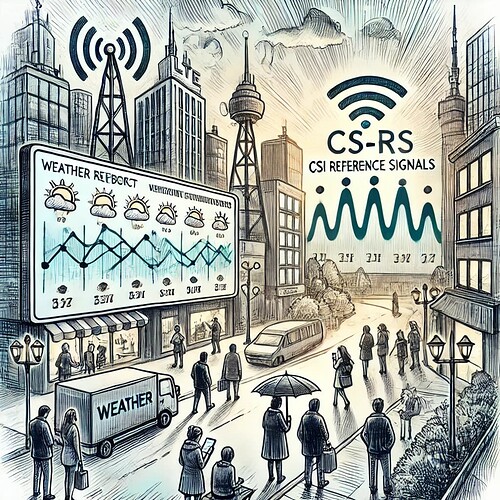This topic presents in a very simplified way all the main concepts that should be understood by those who know LTE.
LTE Downlink Signals
LTE Downlink Signals are essential connect user devices (UEs) to the network, ensuring that data is transmitted efficiently from cell towers to your mobile device.
These signals work together to help your device connect to the network, maintain a strong connection, optimize data transfer and adapts to network conditions.
Understanding these signals helps explain how LTE networks provide fast and reliable wireless communication, ensuring you stay connected wherever you are.
![]() Imagine LTE as a big, bustling city where different signals help everything run smoothly. Each of these signals has a specific job, and by understanding them, you can see how LTE networks work like a well-organized city, making sure everyone stays connected and everything runs smoothly!
Imagine LTE as a big, bustling city where different signals help everything run smoothly. Each of these signals has a specific job, and by understanding them, you can see how LTE networks work like a well-organized city, making sure everyone stays connected and everything runs smoothly!
Skip to: Roadmap to LTE
- Primary Synchronisation Signal (PSS)
- Secondary Synchronisation Signal (SSS)
- Cell Specific Reference Signals (CRS)
- MBSFN Reference Signals
- UE Specific Reference Signals (UE-RS)
- Positioning Reference Signals (PRS)
- CSI Reference Signals (CSI-RS)
Primary Synchronisation Signal (PSS)
This signal helps your device detect the presence of a network and synchronize its timing with the cell tower. (Helps devices identify and synchronize with a specific LTE cell for initial connection).
![]() Think of this as the city’s main clock tower. It helps everyone in the city know what time it is so they can all be on the same schedule. It helps your device find the LTE network for the first time. It’s like a beacon that tells your device where the cell tower is.
Think of this as the city’s main clock tower. It helps everyone in the city know what time it is so they can all be on the same schedule. It helps your device find the LTE network for the first time. It’s like a beacon that tells your device where the cell tower is.
- Search Forum
 Primary Synchronisation Signal (PSS)
Primary Synchronisation Signal (PSS) 
Secondary Synchronisation Signal (SSS)
Working alongside the PSS, this signal helps your device identify specific cells within the network and further refines the synchronization process. (Provides additional cell identification and time synchronization, working together with PSS).
![]() This is like the city’s street signs. After you know the time from the clock tower, the street signs help you find your way to different neighborhoods.It works with the PSS to help your device understand the tower’s schedule. It lets your device know when it can send and receive information.
This is like the city’s street signs. After you know the time from the clock tower, the street signs help you find your way to different neighborhoods.It works with the PSS to help your device understand the tower’s schedule. It lets your device know when it can send and receive information.
- Search Forum
 Secondary Synchronisation Signal (SSS)
Secondary Synchronisation Signal (SSS) 
Cell Specific Reference Signals (CRS)
These signals are used by all devices in a cell to improve signal quality by correcting any errors caused by varying channel conditions. (Allow the device to measure the quality of the LTE cell’s signal and help in decoding the data).
![]() Imagine these as the city’s streetlights. They help light up the streets so everyone can see clearly and avoid getting lost or bumping into things. They are like check-ins that the tower sends out regularly. They help your device measure how strong and clear the tower’s signal is.
Imagine these as the city’s streetlights. They help light up the streets so everyone can see clearly and avoid getting lost or bumping into things. They are like check-ins that the tower sends out regularly. They help your device measure how strong and clear the tower’s signal is.
- Search Forum
 Cell Specific Reference Signals (CRS)
Cell Specific Reference Signals (CRS) 
 LTE Cell Specific Reference Signals (CRS) as city streetlights.
LTE Cell Specific Reference Signals (CRS) as city streetlights.
MBSFN Reference Signals
These signals support multicast or broadcast services, allowing multiple users to receive the same content simultaneously without additional strain on the network. (Support broadcasting services (like TV) by enabling data transmission to many users at once).
![]() These are like the city’s big TV screens in the town square. They show the same movie or news to everyone at the same time, so everyone can watch together without needing their own TV. They are used when lots of devices need to receive the same message at the same time, like watching the same TV show. It makes it easier to share big messages with many people at once.
These are like the city’s big TV screens in the town square. They show the same movie or news to everyone at the same time, so everyone can watch together without needing their own TV. They are used when lots of devices need to receive the same message at the same time, like watching the same TV show. It makes it easier to share big messages with many people at once.
- Search Forum
 MBSFN Reference Signals
MBSFN Reference Signals 
 LTE MBSFN Reference Signals as the city’s big TV screens in a town square.
LTE MBSFN Reference Signals as the city’s big TV screens in a town square.
UE Specific Reference Signals
In addition to the Cell-specific RS, the base station may transmit UE-specific RS. Tailored for individual devices, these signals help optimize performance by providing personalized adjustments to data transmission. (Target individual devices for personalized communication and signal improvements).
![]() Think of these as personalized maps given to each person. These maps help you find the best route to your destination based on where you are and where you want to go. They are just for your device. They make sure your device can hear the network clearly and receive messages just for you.
Think of these as personalized maps given to each person. These maps help you find the best route to your destination based on where you are and where you want to go. They are just for your device. They make sure your device can hear the network clearly and receive messages just for you.
- Search Forum
 UE Specific Reference Signals (UE-RS)
UE Specific Reference Signals (UE-RS) 
Positioning Reference Signals (PRS)
These signals enable accurate positioning of your device within the network, which is essential for location-based services. (Assist in locating a device’s position within the network).
![]() These are like the city’s GPS system. They help you know exactly where you are in the city, which is super helpful if you need to find a specific place. They help the network figure out where your device is. It’s like using a map to find your location.
These are like the city’s GPS system. They help you know exactly where you are in the city, which is super helpful if you need to find a specific place. They help the network figure out where your device is. It’s like using a map to find your location.
- Search Forum
 LTE Positioning Reference Signals (PRS)
LTE Positioning Reference Signals (PRS) 
CSI Reference Signals (CSI-RS)
These signals provide feedback on the quality of the channel between your device and the cell tower, allowing for dynamic adjustments to improve data transmission efficiency. (Help the device report back signal quality to the network for optimal performance and adjustments).
![]() Imagine these as the city’s weather reports. They tell you about the current conditions, like if it’s sunny or rainy, so you can decide the best way to travel around the city. The CSI Reference Signals help your device tell the network how strong the signal is. This helps the network make sure you have the best connection possible.
Imagine these as the city’s weather reports. They tell you about the current conditions, like if it’s sunny or rainy, so you can decide the best way to travel around the city. The CSI Reference Signals help your device tell the network how strong the signal is. This helps the network make sure you have the best connection possible.
- Search Forum
 LTE CSI Reference Signals (CSI-RS)
LTE CSI Reference Signals (CSI-RS) 
That’s it. ![]()
-
Continue reading: Roadmap to LTE - Downlink Physical Channels
-
Or back to: Roadmap to LTE






